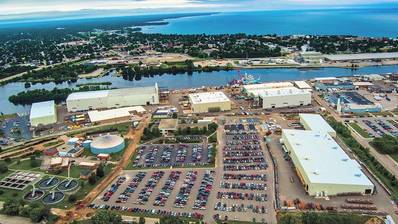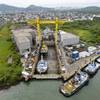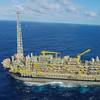Big investments, lean manufacturing techniques borrowed from the automotive industry, and a more engaged workforce have revamped the Wisconsin shipyard where Italy's Fincantieri SpA builds the Freedom variant of the U.S. Navy's coastal warships for prime contractor Lockheed Martin Corp.
Fincantieri invested $100 million in recent years to transform the 1940s era shipyard into a state-of-the-art facility, where seven LCS ships are now under construction, including three that have already been launched into the river.
Fincantieri and Lockheed hope to leverage the resulting savings in a multibillion-dollar U.S. Navy competition expected to kick off in late fiscal 2017 for 20 frigates, or upgraded versions of the current Littoral Combat Ships (LCS).
The Navy plans to buy 32 of the current LCS models built by Lockheed and Australia's Austal Ltd. It is expected to decide in 2017 whether to keep ordering both models, or neck down to one provider.
Jan Allman, who took over as president of Marinette Marine last year after nearly three decades in the automotive and truck business, walks the 550,000-square-foot (51,097-square-meter)shipyard every day, gathering tips from workers about how to improve production.
Last month, Allman told Reuters, one worker told her she had saved hundreds of dollars a month by handing out only a small amount of titanium grease for workers' daily use, instead of a full $20 can that would be thrown away at the end of the day.
"Every penny adds up," said Allman, who drew on her automotive industry experience to help draft new written guiding principles for the shipyard that emphasize continuous improvement, and urge workers to spend money as if it were their own.
Lawmakers and watchdog groups have criticized early cost growth and technical challenges on the LCS ships, but Navy officials say costs have come down sharply, and the ships are performing well in early deployments in Asia and elsewhere.
For instance, the Navy's last contract with Lockheed, for LCS 21, was priced at $362 million when it was awarded in April, compared with $537 million for the first of the steel monohull ships Lockheed built for the Navy.
Lockheed is also eyeing foreign sales in coming years. Sources familiar with the talks told Reuters this week that the U.S. government was in advanced talks with the Saudi government about the sale of two Lockheed frigates in a deal worth well over $1 billion.
Allman, who is pressing to meet aggressive internal cost targets, said she receives about 200 suggestions during small, quarterly meetings with nearly all 1,500 full-time employees at the yard, located about 55 miles (89 km) north of Green Bay.
"She's down there with her steel-toed boots and hard hat," Rear Admiral Brian Antonio, the Navy's program executive officer for Littoral Combat Ships, told Reuters in a recent interview.
"We like what we see, from the way she's energizing her workforce. It makes a big difference in quality and the amount of rework because people are taking more pride in their job."
For instance, he said, the level of rework - components that must be redone due to quality problems - was halved from single-digit percentage levels on LCS 5 to LCS 9, the future USS Little Rock, which was launched into the Menominee River in July.
He said the ship was also 80 percent complete when it launched, the highest level of completion seen on any LCS hull.
Antonio said the Navy welcomed the improvements. "The changes they've made to the shipyard ... will allow them to be more competitive as we move forward into the frigate."
Fincantieri's changes included paving the entire facility and doubling the indoor production space, including construction of a huge building where two of the 118-meter (387.14 ft)warships are now being assembled at once. It also streamlined the flow of raw materials and assembly functions to remove a full 8 miles from the production process of each ship.
Other changes include higher rates of recycling, greater use of fixed assembly platforms, earlier installation of shipboard lighting rather than clamp-on lights, and more work assembling large modules on the ground, rather than on board the ships.
Joe North, Lockheed's vice president of Littoral Ships and Systems, said the transformation reminds him of the scene in the movie "The Wizard of Oz," when Dorothy's entire house lands squarely on the wicked witch.
"If you look at the pictures, a new shipyard came down on top of the old one and brought with it a state-of-the-art capability," he said.
(By Andrea Shalal; Editing by Matthew Lewis)













